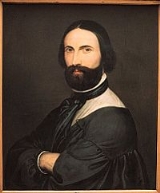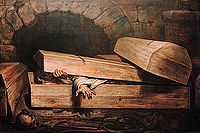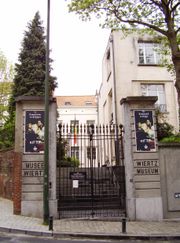
Antoine Wiertz
Encyclopedia
Antoine Joseph Wiertz was a Belgian
romantic
painter
and sculptor
.
from a relatively poor family, he entered the Antwerp art academy in 1820. Thanks to his protector Pierre-Joseph de Paul de Maibe, a member of the Second Chamber of the States-General, king William I of the Netherlands
awarded an annual stipend to Wiertz from 1821 onwards. Between November 1829 and May 1832, he stayed in Paris
, where he studied the old masters at the Louvre
.
In 1828, Wiertz took part in the Grand Concours, also known as Concours de Rome, but came out only second. He landed the prestigious Prix de Rome only at his second attempt in 1832, which enabled him to go to Rome
, where he resided from May 1834 until February 1837. Upon his return, he established himself in Liège with his mother.
During his stay in Rome, Wiertz worked on his first great work, Les Grecs et les Troyens se disputant le corps de Patrocle ("Greeks and Trojans fighting for the body of Patrocles
", finished in 1836), on a subject borrowed from canto XVII of Homer
's Iliad
. It was exhibited in Antwerp in 1837, where it met with some success. Wiertz submitted the work for the Paris
Salon of 1838, but it arrived too late and was refused.
At the Paris Salon of 1839, Wiertz showed not only his Patrocles, but also three other works: Madame Laetitia Bonaparte sur son lit de mort ("Madame Laetitia Bonaparte
on her deathbed"), La Fable des trois souhaits—Insatiabilité humaine ("The fable of the three wishes—Human insatiability") and Le Christ au tombeau ("Christ entombed"). Badly hung and lit, his entry elicited indifference on the part of the public, and provoked sarcasm among the critics. This second humiliation led to a profound rancour against art critics and against Paris, as expressed in his virulent pamphlet Bruxelles capitale, Paris province.
In 1844, Wiertz painted a second version of his Patrocles on an even bigger scale than the first (the 1836 version measures 3.85m by 7.03m; the 1844 version 5.20m by 8.52). The Rome version is now in the Museum of Walloon Art in Liège, the 1844 in the Wiertz Museum in Brussels
.
After the Paris disaster, Wiertz veered more and more to the excessive. A fine example is the monumental La Chute des Anges rebelles ("The Fall of the rebellious Angels", 1841), on an arched canvas of 11.53m by 7.93m.
The death of his mother in 1844 was a terrible blow to the artist. He left Liège in 1845 to settle in Brussels for good. During this period he painted a confrontation of Beauty and Death, Deux jeunes filles—La Belle Rosine (1847), which remains perhaps his most famous work.
Dissatisfied with the shiny effect of oil painting
, he developed a new technique combining the smoothness of oil painting with the speed of execution and the dullness of painting in fresco
. This technique of mat painting entailed the use of a mixture of colours, turpentine and petrol on holland. La Lutte homérique ("The Homeric struggle", 1853) was the first big-scale painting executed in this technique. However, the components used in this technique are responsible for the slow decay of the works produced with it.
 Many of his works from the 1850s have a social of philosophical message, often translated in delirious imagery, like Faim, Folie et Crime ("Hunger, Madness and Crime", 1853), La Liseuse de Romans ("The Reader of Novels", 1853), Le Suicide ("The Suicide", 1854), L'Inhumation précipitée ("The premature burial", 1854), Le Dernier Canon ("The last gun", 1855).
Many of his works from the 1850s have a social of philosophical message, often translated in delirious imagery, like Faim, Folie et Crime ("Hunger, Madness and Crime", 1853), La Liseuse de Romans ("The Reader of Novels", 1853), Le Suicide ("The Suicide", 1854), L'Inhumation précipitée ("The premature burial", 1854), Le Dernier Canon ("The last gun", 1855).
Wiertz was also a fine portrait painter, who made self-portraits at various ages. As a sculptor, he produced his most important project towards the end of his life: a series of plasters representing Les Quatre Âges de l'Humanité ("The Four Ages of Humanity", 1860–1862), reproduced in marble for the Wiertz museum by Auguste Franck.
After difficult negotiations with the Belgian government, Wiertz was able to realize his dream to turn his last studio into a museum for his works. The Belgian State bought a piece of land and funded the construction of a huge hall to accommodate the painter's monumental works. In exchange, Wiertz donated all his works to the Belgian State, with the express proviso that they should remain in his studio both during and after his lifetime.
Wiertz died in his studio. His remains were embalmed in accordance with Ancient Egyptian burial rites and buried in a vault in the municipal cemetery of Ixelles.
Influenced mainly by Rubens and the late Michelangelo
, Wiertz' monumental painting often moves between classical academism and lurid romanticism, between the grandiose and the ridiculous. Although his work was often derided as art pompier, his pictorial language nevertheless preannounced symbolism and a certain kind of surrealism, two currents that would be very strong in Belgian painting.
A copy of one of Antoine Wiertz's works, the statue of The Triumph of Light was once prominently located high on San Francisco's Mount Olympus between the Haight-Ashbury and Corona Heights. It had been presented to the city of San Francisco by Adolph Sutro
in 1887. Over the years due to lack of care and maintenance the statue fell into disrepair. By the late 1930s, even the history and origins of the statue were no longer common knowledge in San Francisco, and by the mid 1950s, the statue disappeared. All that remains today is the pedestal and base of the monument.
 The Antoine Wiertz Museum is now one of the Royal Museums of Fine Arts of Belgium
The Antoine Wiertz Museum is now one of the Royal Museums of Fine Arts of Belgium
. It is located in the Leopold district of Brussels, near the Luxembourg railway station
, today overshadowed by the European Parliament complex
. The Rue Wiertz runs from the museum through the Parliament complex, in an unintended echo of Wiertz' call for Brussels to become the capital of Europe.
Contemporary opinions of the museum and the works therein are mixed:
Belgium
Belgium , officially the Kingdom of Belgium, is a federal state in Western Europe. It is a founding member of the European Union and hosts the EU's headquarters, and those of several other major international organisations such as NATO.Belgium is also a member of, or affiliated to, many...
romantic
Romanticism
Romanticism was an artistic, literary and intellectual movement that originated in the second half of the 18th century in Europe, and gained strength in reaction to the Industrial Revolution...
painter
Painting
Painting is the practice of applying paint, pigment, color or other medium to a surface . The application of the medium is commonly applied to the base with a brush but other objects can be used. In art, the term painting describes both the act and the result of the action. However, painting is...
and sculptor
Sculpture
Sculpture is three-dimensional artwork created by shaping or combining hard materials—typically stone such as marble—or metal, glass, or wood. Softer materials can also be used, such as clay, textiles, plastics, polymers and softer metals...
.
Biography
Born in DinantDinant
Dinant is a Walloon city and municipality located on the River Meuse in the Belgian province of Namur, Belgium. The Dinant municipality includes the old communes of Anseremme, Bouvignes-sur-Meuse, Dréhance, Falmagne, Falmignoul, Foy-Notre-Dame, Furfooz, Lisogne, Sorinnes, and Thynes.-Origins to...
from a relatively poor family, he entered the Antwerp art academy in 1820. Thanks to his protector Pierre-Joseph de Paul de Maibe, a member of the Second Chamber of the States-General, king William I of the Netherlands
William I of the Netherlands
William I Frederick, born Willem Frederik Prins van Oranje-Nassau , was a Prince of Orange and the first King of the Netherlands and Grand Duke of Luxembourg....
awarded an annual stipend to Wiertz from 1821 onwards. Between November 1829 and May 1832, he stayed in Paris
Paris
Paris is the capital and largest city in France, situated on the river Seine, in northern France, at the heart of the Île-de-France region...
, where he studied the old masters at the Louvre
Louvre
The Musée du Louvre – in English, the Louvre Museum or simply the Louvre – is one of the world's largest museums, the most visited art museum in the world and a historic monument. A central landmark of Paris, it is located on the Right Bank of the Seine in the 1st arrondissement...
.
In 1828, Wiertz took part in the Grand Concours, also known as Concours de Rome, but came out only second. He landed the prestigious Prix de Rome only at his second attempt in 1832, which enabled him to go to Rome
Rome
Rome is the capital of Italy and the country's largest and most populated city and comune, with over 2.7 million residents in . The city is located in the central-western portion of the Italian Peninsula, on the Tiber River within the Lazio region of Italy.Rome's history spans two and a half...
, where he resided from May 1834 until February 1837. Upon his return, he established himself in Liège with his mother.
During his stay in Rome, Wiertz worked on his first great work, Les Grecs et les Troyens se disputant le corps de Patrocle ("Greeks and Trojans fighting for the body of Patrocles
Patrocles
Patrocles name may refer to:*Patroclus *Patrocles of Thurii tragic poet 5th c.BC*Patrocles teacher of rhetoric mentioned by Quintilian*Patrocles Macedonian general and writer under Seleucus and Antiochus...
", finished in 1836), on a subject borrowed from canto XVII of Homer
Homer
In the Western classical tradition Homer , is the author of the Iliad and the Odyssey, and is revered as the greatest ancient Greek epic poet. These epics lie at the beginning of the Western canon of literature, and have had an enormous influence on the history of literature.When he lived is...
's Iliad
Iliad
The Iliad is an epic poem in dactylic hexameters, traditionally attributed to Homer. Set during the Trojan War, the ten-year siege of the city of Troy by a coalition of Greek states, it tells of the battles and events during the weeks of a quarrel between King Agamemnon and the warrior Achilles...
. It was exhibited in Antwerp in 1837, where it met with some success. Wiertz submitted the work for the Paris
Paris
Paris is the capital and largest city in France, situated on the river Seine, in northern France, at the heart of the Île-de-France region...
Salon of 1838, but it arrived too late and was refused.
At the Paris Salon of 1839, Wiertz showed not only his Patrocles, but also three other works: Madame Laetitia Bonaparte sur son lit de mort ("Madame Laetitia Bonaparte
Letizia Ramolino
Nobile Maria Letizia Buonaparte née Ramolino was the mother of Napoleon I of France....
on her deathbed"), La Fable des trois souhaits—Insatiabilité humaine ("The fable of the three wishes—Human insatiability") and Le Christ au tombeau ("Christ entombed"). Badly hung and lit, his entry elicited indifference on the part of the public, and provoked sarcasm among the critics. This second humiliation led to a profound rancour against art critics and against Paris, as expressed in his virulent pamphlet Bruxelles capitale, Paris province.
In 1844, Wiertz painted a second version of his Patrocles on an even bigger scale than the first (the 1836 version measures 3.85m by 7.03m; the 1844 version 5.20m by 8.52). The Rome version is now in the Museum of Walloon Art in Liège, the 1844 in the Wiertz Museum in Brussels
Brussels
Brussels , officially the Brussels Region or Brussels-Capital Region , is the capital of Belgium and the de facto capital of the European Union...
.
After the Paris disaster, Wiertz veered more and more to the excessive. A fine example is the monumental La Chute des Anges rebelles ("The Fall of the rebellious Angels", 1841), on an arched canvas of 11.53m by 7.93m.
The death of his mother in 1844 was a terrible blow to the artist. He left Liège in 1845 to settle in Brussels for good. During this period he painted a confrontation of Beauty and Death, Deux jeunes filles—La Belle Rosine (1847), which remains perhaps his most famous work.
Dissatisfied with the shiny effect of oil painting
Oil painting
Oil painting is the process of painting with pigments that are bound with a medium of drying oil—especially in early modern Europe, linseed oil. Often an oil such as linseed was boiled with a resin such as pine resin or even frankincense; these were called 'varnishes' and were prized for their body...
, he developed a new technique combining the smoothness of oil painting with the speed of execution and the dullness of painting in fresco
Fresco
Fresco is any of several related mural painting types, executed on plaster on walls or ceilings. The word fresco comes from the Greek word affresca which derives from the Latin word for "fresh". Frescoes first developed in the ancient world and continued to be popular through the Renaissance...
. This technique of mat painting entailed the use of a mixture of colours, turpentine and petrol on holland. La Lutte homérique ("The Homeric struggle", 1853) was the first big-scale painting executed in this technique. However, the components used in this technique are responsible for the slow decay of the works produced with it.

Wiertz was also a fine portrait painter, who made self-portraits at various ages. As a sculptor, he produced his most important project towards the end of his life: a series of plasters representing Les Quatre Âges de l'Humanité ("The Four Ages of Humanity", 1860–1862), reproduced in marble for the Wiertz museum by Auguste Franck.
After difficult negotiations with the Belgian government, Wiertz was able to realize his dream to turn his last studio into a museum for his works. The Belgian State bought a piece of land and funded the construction of a huge hall to accommodate the painter's monumental works. In exchange, Wiertz donated all his works to the Belgian State, with the express proviso that they should remain in his studio both during and after his lifetime.
Wiertz died in his studio. His remains were embalmed in accordance with Ancient Egyptian burial rites and buried in a vault in the municipal cemetery of Ixelles.
Influenced mainly by Rubens and the late Michelangelo
Michelangelo
Michelangelo di Lodovico Buonarroti Simoni , commonly known as Michelangelo, was an Italian Renaissance painter, sculptor, architect, poet, and engineer who exerted an unparalleled influence on the development of Western art...
, Wiertz' monumental painting often moves between classical academism and lurid romanticism, between the grandiose and the ridiculous. Although his work was often derided as art pompier, his pictorial language nevertheless preannounced symbolism and a certain kind of surrealism, two currents that would be very strong in Belgian painting.
A copy of one of Antoine Wiertz's works, the statue of The Triumph of Light was once prominently located high on San Francisco's Mount Olympus between the Haight-Ashbury and Corona Heights. It had been presented to the city of San Francisco by Adolph Sutro
Adolph Sutro
Adolph Heinrich Joseph Sutro was the 24th mayor of San Francisco, and second Jewish mayor, serving in that office from 1894 until 1896...
in 1887. Over the years due to lack of care and maintenance the statue fell into disrepair. By the late 1930s, even the history and origins of the statue were no longer common knowledge in San Francisco, and by the mid 1950s, the statue disappeared. All that remains today is the pedestal and base of the monument.
Wiertz Museum

Royal Museums of Fine Arts of Belgium
The Royal Museums of Fine Arts of Belgium , is one of the most famous museums in Belgium.-The museum:...
. It is located in the Leopold district of Brussels, near the Luxembourg railway station
Brussels-Luxembourg Station
Brussels-Luxembourg railway station is a station in the European Quarter of Brussels under the Esplanade of the European Parliament .-History:...
, today overshadowed by the European Parliament complex
Espace Léopold
The Espace Léopold or is the complex of parliament buildings in Brussels housing the European Parliament, a legislative chamber of the European Union ....
. The Rue Wiertz runs from the museum through the Parliament complex, in an unintended echo of Wiertz' call for Brussels to become the capital of Europe.
Contemporary opinions of the museum and the works therein are mixed:
- "[The museum] is devoted to the works of one of the city's most distinctive, if disagreeable, nineteenth-century artists."
- "If you're into the shocking or nasty, it [the museum] may appeal."
- "In recent years the Wiertz Museum has attracted an average of just ten visitors a day ... The Belgian state is legally stuck with all 220 of his [Wiertz'] works—dreadful though most of them are—and an obligation to display them forever. ... [Wiertz was] perhaps the worst painter to have a government-funded museum all to himself, at least in the free world ..."

